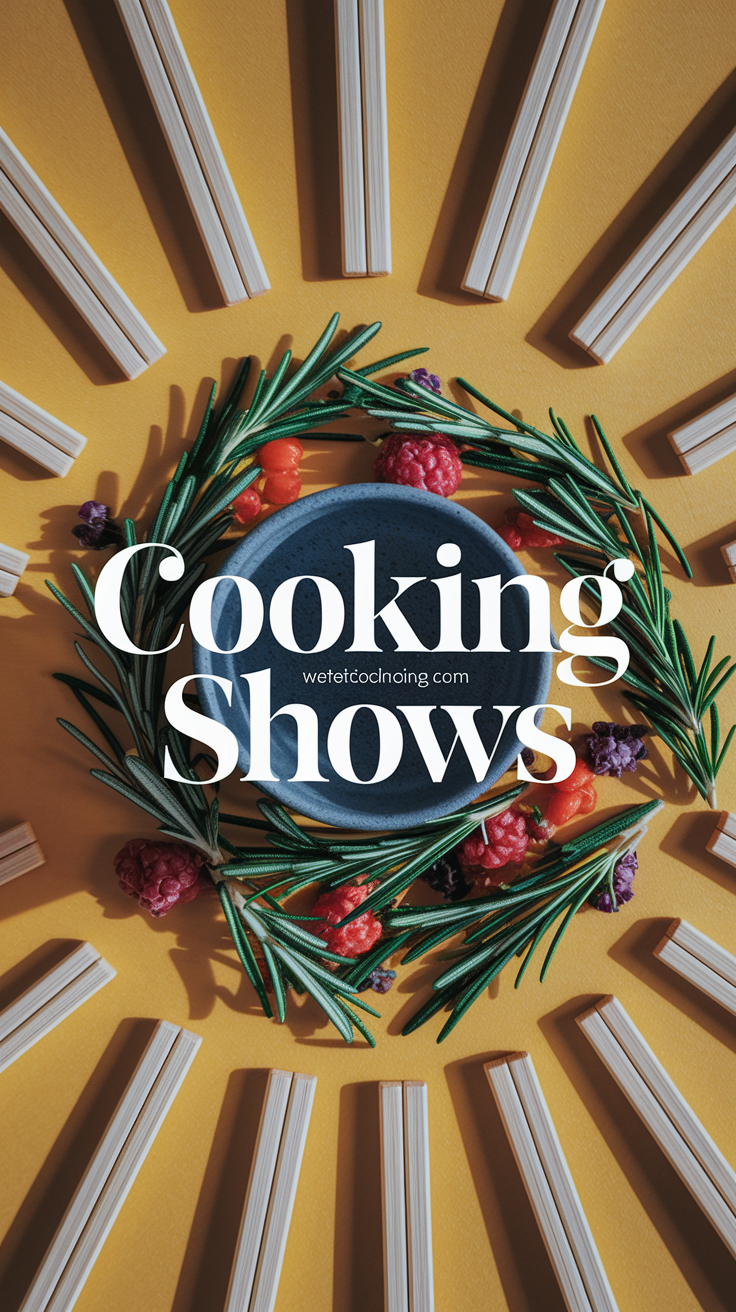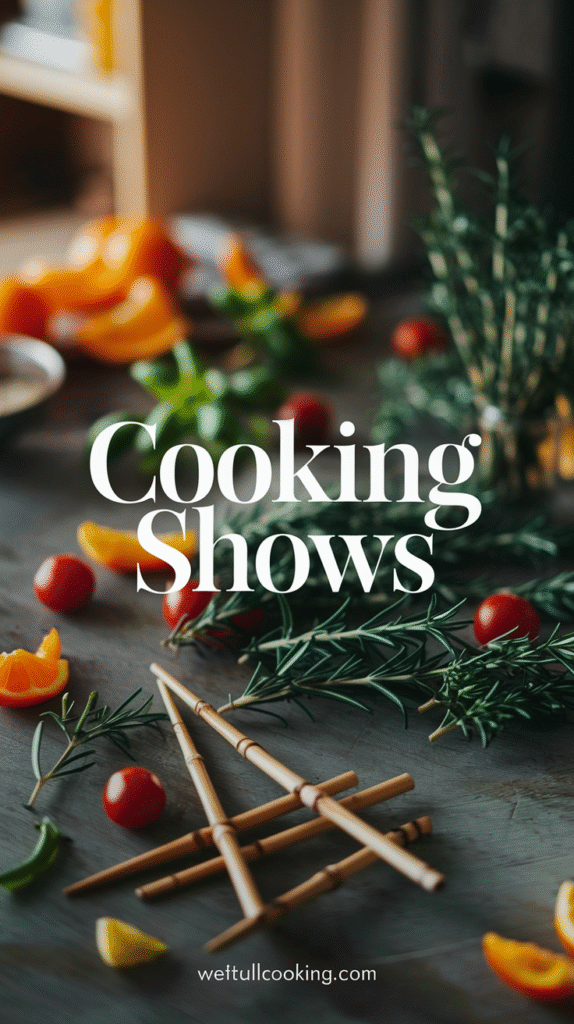The world of cooking shows has transformed dramatically over the decades, captivating audiences with a mix of culinary delight and entertainment. From the early days of televised cooking demonstrations to the current era filled with reality-based competitions, the evolution of cooking shows reflects broader changes in societal tastes and media consumption.
In the 1940s and 1950s, cooking shows were modest and focused primarily on home cooking. Icons like Julia Child changed the game by turning cooking into an art form. Her approachable style and emphasis on technique made gourmet cooking accessible to the average viewer. During this time, television brought the joys of cooking directly into homes, allowing many to learn essential skills. The recipes were simple, and the presentation often lacked the pizzazz of modern-day food TV.
As time progressed, the 1970s and 1980s introduced a more diverse array of cooking shows. Chefs began to experiment with different cuisines, showcasing international dishes that reflected a growing interest in globalization. Shows like The Food Network emerged, paving the way for many chefs, including Bobby Flay and Martha Stewart, to develop their brands. This shift moved cooking shows towards a more polished, television-focused style, emphasizing aesthetic presentations and culinary flair.
In the late 1990s and early 2000s, cooking shows began to shift into the realm of reality TV. With the rise of competition formats, shows like MasterChef and Hell’s Kitchen brought a level of excitement and drama that had never been seen before. Audiences were drawn to the tension of kitchen duels, eliminations, and the triumphs of home cooks. These formats allowed viewers to immerse themselves in narratives, cheering for their favorites while learning about culinary techniques along the way.
Today, the landscape of cooking shows is incredibly varied. From the binge-worthy series on streaming platforms to YouTube channels, the ways people engage with cooking content have multiplied. Popular trends include:
- Quick and Easy Recipes: Many viewers prefer short video segments that deliver quick recipes they can replicate at home.
- Health-Conscious Cooking: Shows that focus on healthy eating habits, emphasizing fresh and organic ingredients, have gained popularity.
- International Flavors: There’s a growing interest in global cuisines, with cooking shows highlighting authentic food from around the world.
- Celebrity Chefs: Famous chefs like Jamie Oliver have turned their cooking shows into lifestyle brands, combining cooking with inspiration for healthier living.
As the format continues to evolve, the interplay between cooking shows and digital platforms also impacts how content is created and consumed. Social media, particularly Instagram and TikTok, allows cooking influencers to capture the attention of viewers with visually stunning short clips. This democratization of content means anyone with a passion for cooking can share their journey and recipes with the world.
The evolution of cooking shows is a fascinating journey that mirrors changes in technology, society, and culinary arts. Each era reflects the interests and values of the time, showcasing the importance of food in cultural expression. As you explore various cooking shows, consider the flavors and techniques that resonate most with you, and maybe even discover a new recipe or two to try at home.
For those looking to dive deeper into the world of cooking shows and discover new culinary inspirations, trustworthy resources like Cooking Channel and Serious Eats can provide valuable insights and recipes to help you along your cooking journey.
How Cooking Shows Inspire Home Cooks to Try New Recipes
Cooking shows have emerged as a favorable influence on home cooks around the world. By showcasing diverse techniques, tools, and recipes, these shows ignite a passion for cooking that encourages viewers to roll up their sleeves and experiment in their own kitchens.
One of the most significant ways cooking shows inspire home cooks is by introducing them to new cuisines. With the help of well-known chefs and engaged hosts, viewers are transported to different countries and cultures. They learn about ingredients and techniques that may be unfamiliar to them. This exposure can lead to a newfound curiosity. By watching shows like Food Network and BBC Food, viewers can discover exciting global dishes that they might want to recreate.
Additionally, cooking shows simplify complex recipes, making them seem more approachable. Hosts often break down the steps clearly and provide helpful tips along the way. Watching an expert tackle a seemingly daunting dish can inspire you to try it yourself, knowing you have guidance at your fingertips.
Here are some key aspects of how cooking shows encourage home cooks:
- Visual Learning: Seeing a dish come together on screen is often far more effective than reading a recipe. Visuals help cooks understand textures, colors, and techniques that are challenging to convey through written instructions.
- Creative Variations: Many cooking shows highlight the importance of customization. Hosts may suggest swapping out ingredients or trying different methods. This idea encourages home cooks to innovate rather than strictly following recipes.
- Engagement with Personal Stories: Many chefs share personal anecdotes while cooking, providing context and connectiveness. This storytelling aspect makes cooking feel more relatable and personal, encouraging viewers to share their own stories through food.
Shows that focus on home cooks can also empower viewers by showcasing everyday people succeeding in the kitchen. The relatability of amateur chefs often inspires viewers who may feel intimidated by culinary school graduates. This sense of community and shared experience can motivate anyone to try a new dish.
Social media has played a crucial role in the cooking show revolution. Platforms like Instagram and TikTok are packed with cooking challenges and tutorials, complementing traditional cooking shows. Users showcase their culinary creations, thus building a community where people share successes, ask for advice, and inspire each other to experiment.
Here’s a look at some of the popular formats of cooking shows that help spur creativity in the kitchen:
| Show Format | Description | Example Shows |
|---|---|---|
| Competitive Cooking | Cooks face off in timed challenges and must impress judges. | MasterChef, Chopped |
| Instructional | Chefs provide step-by-step guidance on recipes and techniques. | Cook’s Country, Julia Child’s Cooking Show |
| Travel and Cuisine | Chefs explore global flavors and cooking styles, often while traveling. | Anthony Bourdain: Parts Unknown, Somebody Feed Phil |
Ultimately, cooking shows inspire home cooks to broaden their culinary horizons. They encourage people to step outside their comfort zones and try new recipes. As viewers gain confidence through shows, they may also introduce others to the joy of cooking, creating a ripple effect in their communities.
Whether you’re an experienced cook or a beginner, finding inspiration in cooking shows can turn routine dinners into exciting culinary adventures. So, next time you tune in to your favorite show, remember that the journey to becoming a better cook starts with that first inspired recipe. Explore more about cooking shows at Cooking Channel and embark on your next cooking adventure!
The Role of Celebrity Chefs in Shaping Culinary Trends
In recent years, cooking shows have surged in popularity, captivating audiences worldwide. These televised programs not only entertain but also shape culinary trends in unexpected ways. With the rise of celebrity chefs, the influence on what we see on our kitchen tables has never been stronger.
Celebrity chefs bring charisma, expertise, and unique culinary styles to our screens. They often introduce viewers to new ingredients, techniques, and global cuisines. As you watch these chefs expertly prepare meals, you find yourself inspired to try your hand at their recipes, often reflecting the latest trends in the food world.
These chefs often serve as trendsetters. Their choice of ingredients and cooking styles can flag major shifts in consumer preferences. For instance, when a well-known chef promotes organic produce or plant-based dishes, it doesn’t take long for viewers to follow suit. The emphasis on farm-to-table practices has found its roots in the culinary world, thanks in large part to celebrity chefs who advocate for sustainability.
| Celebrity Chef | Culinary Trend | Show |
|---|---|---|
| Giada De Laurentiis | Italian-American Fusion | Everyday Italian |
| Jamie Oliver | Healthy Eating | The Naked Chef |
| Wolfgang Puck | Gourmet Pizza | Wolfgang Puck Cooking Class |
| Alton Brown | Scientific Cooking | Good Eats |
The success of cooking shows can often be attributed to the engaging personalities of these chefs. They don’t just present recipes; they tell stories, share personal experiences, and foster connections with their audience. This narrative aspect creates a sense of camaraderie. As viewers, you feel as though you’re part of a collective journey exploring flavors and techniques.
Moreover, the rise of social media has further amplified the influence of celebrity chefs. Platforms like Instagram and TikTok allow chefs to connect with broader audiences instantaneously. A simple post can ignite a culinary movement, as followers recreate trending dishes in their own kitchens. This instantaneous feedback loop ensures that culinary trends evolve rapidly, often influenced directly by what chefs share online.
As celebrity chefs make their mark on trends, there’s a noticeable increase in themed events and collaborations. For instance, seasonal festivals or cooking competitions often feature these culinary icons, helping to launch new culinary concepts. Such events serve as a culinary playground where chefs showcase their creativity, inspiring both aspiring home cooks and gourmet enthusiasts.
In addition to promoting new dishes, celebrity chefs also advocate for health-conscious eating. Many chefs are now focusing on wellness trends, emphasizing nutrition and balanced meals. The rise of cooking shows that highlight low-carb, keto-friendly, or gluten-free recipes is a testament to this shift. As viewers become more health-conscious, culinary programming reflects their desires, making healthy cooking accessible and fun.
- Chopped – a competition format that inspires creativity.
- ChefSteps – focusing on modern scientific techniques.
- MasterChef – showcasing amateur chefs trying to impress culinary legends.
Each of these shows plays a vital role in bringing new culinary techniques and trends to the forefront, ensuring that viewers are always in touch with the evolving food landscape.
As you think about the impact of cooking shows, it’s important to recognize that they do more than just entertain. They educate, inspire, and connect communities over a shared love for food. Whether it’s through mastering a complex recipe, exploring cross-cultural flavors, or simply feeling more confident in the kitchen, the influence of celebrity chefs continues to grow. Their magic lies in making cooking accessible and exciting, turning everyday meals into opportunities for creativity and exploration.
In the ever-changing world of culinary arts, celebrity chefs stand as beacons of innovation, shaping what we eat, how we cook, and even how we think about food. As you tune into your favorite show or follow a chef on social media, remember that you’re part of a vibrant, evolving food culture that celebrates both tradition and modernity.
Interactive Cooking Shows: Engaging Viewers in Real-Time
Cooking shows have come a long way, evolving from traditional formats into interactive experiences that engage viewers in real-time. This new wave of interactive cooking shows enhances how audiences connect with culinary arts, providing a dynamic platform that not only informs but also entertains.
One of the key aspects of interactive cooking shows is the ability to participate in the cooking process. Instead of passively watching a chef prepare a dish, viewers can follow along, ask questions, and share their experiences. This sense of involvement transforms the viewing experience into a communal activity, where home cooks feel empowered and inspired to create alongside the host.
Various platforms have embraced this innovative format, enabling interactive cooking experiences. Streaming services and social media networks are at the forefront of this trend, offering creators new ways to engage with their audience. Shows hosted on platforms like Twitch allow for live interactions, where viewers can comment in real-time, share tips, and even troubleshoot common cooking issues.
One popular format is the live cooking demonstration, where chefs ask viewers to cook a dish step by step. During these sessions, hosts encourage viewers to ask questions via chat, addressing concerns like cooking times or ingredient substitutions. This direct line of communication fosters a sense of community and makes learning to cook more enjoyable and less intimidating.
Furthermore, interactive cooking shows often incorporate fun challenges and games that viewers can participate in. For instance, polls on social media can help the audience choose what dish to cook next. This idea not only keeps the content fresh but also allows viewers to invest personally in the show. By voting for recipes or sharing their twists on dishes, viewers become active contributors to the cooking experience.
Cooking competitions have also adopted interactive elements. Many shows now ask viewers to vote on their favorite contestants or dishes. For example, a live cooking competition on a platform like Food Network may ask viewers to submit ideas or suggest ingredients, creating a rich interaction layer where every vote counts. This inclusion encourages viewer loyalty and creates a deeper connection with the show.
The rise of cook-along videos is another exciting development in this realm. In these videos, viewers are guided through each step of a recipe while the host prepares the same dish in real-time. Ingredients are often displayed on-screen, making it easy to follow along. This hands-on approach allows users to pause, rewind, and replay sections as needed, transforming the cooking show from mere entertainment to an educational experience.
To enhance your interactive cooking experience, consider incorporating the following tips:
- Engage with the Host: Don’t hesitate to ask questions during the show. Most interactive programs encourage this kind of participation.
- Share Your Results: Use social media platforms to showcase your cooking triumphs and connect with others who are participating.
- Try New Recipes: Embrace the opportunity to experiment with unfamiliar ingredients or techniques presented in the show.
- Use Polls and Challenges: Participate in polls that might shape the episode and vote on recipes or challenges whenever applicable.
The future of cooking shows looks bright with the integration of enhanced interactivity. Content creators are continuously experimenting with innovative ideas, encouraging audiences to dive into cooking with renewed enthusiasm. By joining such shows, you not only improve your culinary skills but also become part of a vibrant community of food lovers.
Ultimately, interactive cooking shows redefine what it means to watch and learn about cooking. They break down the barriers between chef and viewer, making culinary skills accessible and fun for all. By embracing the interactive approach, cooking shows turn a solitary activity into a shared journey, one recipe at a time.
For those who are looking to delve deeper into the world of interactive cooking shows, explore platforms like BBC Food that offer a wealth of engaging cooking content and community-driven experiences.
The Impact of Cooking Shows on Food Culture and Consumer Choices
Cooking shows have significantly transformed food culture and consumer choices in recent years. With the rise of platforms like YouTube, Netflix, and traditional television networks, audiences are introduced to a variety of cuisines, cooking techniques, and food philosophies. These shows do more than entertain; they educate, inspire, and even influence shopping habits.
One of the most notable impacts of cooking shows is their ability to democratize knowledge about food. Viewers gain access to techniques and recipes that might have previously seemed intimidating. This accessibility fosters greater culinary confidence among home cooks. Whether you’re a novice or a seasoned chef, these programs offer something for everyone. This shift towards cooking at home enhances the value placed on home-cooked meals, sparking an interest in the quality of ingredients used and methods employed.
Cooking shows often highlight the importance of fresh and local ingredients. Chefs frequently emphasize farm-to-table concepts and sustainable cooking practices. This exposure increases consumer awareness about food sourcing and encourages a more conscientious approach to grocery shopping. People begin to consider the origins of their food and make healthier choices. As viewers witness chefs prioritizing fresh vegetables, organic meats, and ethically sourced seafood, this behavior reflects in their consumer habits.
The popularity of cooking shows has also driven businesses to adapt their marketing strategies. Grocery stores and food brands are tapping into this trend by promoting products featured on popular programs. For instance, if a well-known chef demonstrates a recipe using a specific brand of olive oil, that product often sees a spike in sales. This correlation between media visibility and consumer behavior is a phenomenon worth noting.
Additionally, the diversity of cooking shows allows viewers to explore cuisines from all over the world. Programs like “MasterChef,” “The Great British Bake Off,” and “Top Chef” expose audiences to cultural dishes enriching culinary experiences. By popularizing global flavors, cooking shows expand palates and encourage viewers to step outside their comfort zones. This exploration can lead to a newfound appreciation for different cultures, fostering tolerance and connection through food.
Another noteworthy aspect is the role of celebrity chefs. Personalities like Gordon Ramsay, Julia Child, and Rachael Ray have become household names, often influencing viewer behavior and choices. A charismatic host can create an emotional connection with the audience, prompting them to replicate the recipes in their own kitchens. This “celebrity influence” often extends beyond cooking, impacting viewers’ overall lifestyle and approach towards nutrition.
Moreover, cooking shows often feature challenges and competitions that spark creativity and innovation among amateur cooks. These formats encourage viewers to try new techniques and experiment with ingredients. The thrill of cooking under pressure displays the transformative power of creativity in the kitchen, pushing home cooks to recreate those experiences. As a result, many aspire to share their culinary creations on platforms like Instagram and TikTok, further spreading the culinary culture depicted in these shows.
However, not all impacts of cooking shows are positive. The emphasis on perfection and competition may set unrealistic expectations for home cooks. Some viewers might feel discouraged if their outcome does not match that portrayed on-screen. This scenario can lead to feelings of inadequacy and impact a person’s confidence in their culinary skills. Balancing inspiration with realism is essential for the growth of home cooking.
Here’s a glimpse into the positive and negative impacts of cooking shows:
| Positive Impacts | Negative Impacts |
|---|---|
| Encourages home cooking | Sets unrealistic standards |
| Promotes awareness of food sourcing | May discourage novice cooks |
| Diversifies culinary experiences | Increases anxiety about cooking |
| Inspires creativity | Pursuit of perfection can be stressful |
Ultimately, cooking shows play a pivotal role in shaping food culture and consumer choices. They inspire individuals to explore their culinary journeys while educating audiences about nutrition and sustainability. By balancing inspiration with achievable goals, these programs can create a more enriched food environment. To see how these trends unfold, you might want to check resources on food culture like Food & Wine or Serious Eats.
The exploration of flavors, cultures, and cooking methods through cooking shows continues to inspire new generations of cooks. By recognizing both their benefits and drawbacks, you can better navigate the culinary landscape and enjoy home cooking at its finest.
Conclusion
Cooking shows have transformed significantly over the years, moving from the classic formats of the past to the dynamic and engaging reality TV we see today. They have become vital resources for home cooks, inspiring people to step out of their culinary comfort zones and experiment with new recipes and techniques. These shows not only provide entertainment but also serve as platforms for learning and creativity in the kitchen.
Celebrity chefs play a crucial role in shaping culinary trends, bringing unique styles and flavors into mainstream culture. Their influence stretches beyond the screen, impacting what ingredients are popular and how people approach home cooking. As they share tips, tricks, and personal stories, viewers often feel a connection that motivates them to replicate these elevated dishes.
Interactive cooking shows take viewer engagement to a new level, allowing audiences to participate and cook along in real-time. This innovative approach demystifies cooking for many, making it accessible and fun. Participants can ask questions and receive instant feedback, enhancing the home cooking experience.
Cooking shows have profoundly impacted food culture and consumer choices. They not only educate viewers about various cuisines and cooking methods but also encourage healthier eating habits and the exploration of diverse ingredients. As they adapt and evolve, cooking shows will continue to inspire and connect with audiences, reinforcing the idea that cooking is not just a necessity, but also a passion that can bring people together. Whether you’re a novice or an experienced chef, there’s something to learn and enjoy from today’s vibrant cooking show landscape.







Leave a Reply